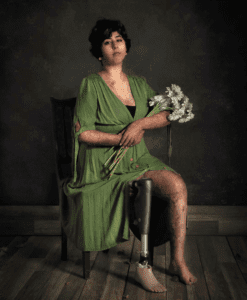
Ending amputee helplessness sounds easy but you must understand what causes it and how to stop it in its tracts. Every amputee must face feelings of helplessness at some point in their recovery. For amputees who wake in the ER after a car wreck, it may be sooner. Your first reaction is denial or overwhelming helplessness, especially facing the reality that you have a family to support or a job to do, and you can’t right now. The other helplessness is more insidious.
Facing the loss of a limb due to diabetes or some other medical condition, you feel more helpless. One amputee describes it as” being lost in an assembly line of care.” As a result, you may have been passed along from one healthcare provider to another, left feeling lost with nowhere to turn and utterly helpless.
Recognizing feeling helpless
In 1996, I visited my general practitioner for a wound on my foot that refused to go away. For the next several months, he tried unsuccessfully to get it to close up. After six months of unsuccessful treatment, different shoes, and blood flow tests, I was referred to a podiatrist who unsuccessfully treats the wound for the next few years. The ulcers appear on both feet. Finally, I was referred to an orthopedic surgeon who, over the next ten years, cut off parts of the foot he felt were infected. Consultations with foot specialists at the Mayo clinic proved equally futile. Eventually, I was referred for amputation because although nothing was getting better, it wasn’t getting worse.
I was told after a brief stay in the hospital, I would be on my new feet in no time, just like my surgeon’s sister. The vascular surgeon took control, and the foot was amputated. Following the amputation, I end up with my wife in a hospital room, looking down where my leg used to be, feeling hopeless and helpless. In all of the confusion, I was told my general physician was now in charge. He did not know of my amputation, so I had to schedule an appointment with him myself. I had no idea what the future holds as an amputee. Unfortunately, at this stage of the process, the prosthetic provider becomes just another face in the crowd, or worse, has never been in this situation before.
Amputation Helplessness and Locus of Control
Locus of control theory by Julia Rotter postulates that individuals have either an internal or external locus of control. An individual with a strong internal locus of control believes that they are in control of their bodies and lives. Those with a strong external locus of control believe that things in life are bound to occur and that an individual has minimal if any, control over these outcomes. Individuals who have a strong external locus of control tend to be more prone to blame outside forces for their misfortunes. Amputees with an internal locus of control feel less helpless. When an external locus of control person gets an amputation, they feel a stronger sense of helplessness.
Learned Helplessness
Helplessness is harder to overcome when you feel that circumstances have more control over your life than you do. When that feeling reaches a terrorizing level, it becomes a phenomenon called “learned helplessness.” It’s when a person feels so powerless to control their circumstances that they stop making any efforts to change them. It is very common among survivors of abuse and trauma, especially victims of childhood trauma (Thompson, 2014).
In the 1960s, psychologist Martin Seligman Ph.D. conducted a rather ruthless, yet revealing experiment. He administered electric shocks to dogs and discovered something rather startling. After a while, they stopped trying to escape being shocked. In human terms when someone has endured repeated adversity that they feel is beyond their control they give up trying. He called this phenomenon, “learned helplessness.” In humans, it is a belief that their innate ability to achieve goals is suspended.
He discovered that even when the dogs knew they had an opportunity to escape, they gave up on the initiative to do so after recognizing that their efforts might be in vain. However, the dogs who had not been previously shocked were able to escape because they had not yet been conditioned to believe that their behavior did not make a difference.
The dogs who did not have the previous helpless experience learned how to escape because their past experiences did not limit their choices. They discovered they had some sense of control. In the context of learning theory, they were being trained by what behavioral psychologists call negative reinforcement, in which a response like jumping is strengthened by the removal of a negative stimulus or no longer being shocked.
They learned that it was rewarding for them to escape to safety. Dogs who developed a sense of learned helplessness due to previous shocks, however, gave immediately because they learned that there was no reward and developed a sense that their situation was inescapable.
Amputation Learned Helplessness
Applying the results of this experiment to human behavior, the theory of learned helplessness can show some insights into people’s reactions to amputations. When you do not want to get up and walk again is the same learned helplessness that the dogs felt.
Learned helplessness may explain amputees not getting out of their wheelchairs. It describes having the muscle strength to walk while refusing to get up or work on their physical rehabilitation.
As learned from Seligman’s (albeit cruel) experiments on dogs, those who develop learned helplessness ignore routes of escape or options to change their circumstances even if those opportunities are available. They may give up or give in even if they have ways to channel their experiences or overcome their adversity constructively.
Ending Amputee Helplessness
The core of treatment for learned helplessness is finding a good therapist. There is a specialist in working with amputees, even having an amputation themselves.
Therapies like Cognitive Behavioral Therapy, for example, allow you to focus on changing your thoughts and cognitive biases to modify your behavior. This can help you to battle the black-and-white thinking that often accompanies learned helplessness.
To do this, you – ironically enough – have to give up some control. You have to practice effective techniques that reframe your usual ways of thinking. Rather than jumping to thoughts like “This is useless,” or “I give up,” you have to start to replace unhelpful distortions with healthier modes of thinking, like “There are certain aspects of life that cannot be controlled. I cannot control how others think of me or how they react to me. However, I can control how I react to other people.” You may not be able to control what other people are willing to give you. But you can control what opportunities you create for yourself. These new thoughts will allow you to increase your sense of perceived agency, and you will then be more willing to see opportunities for growth as they arise.
For those amputees feeling like giving up, these changed belief systems could lead them to seek physical rehab and peer support from fellow amputees. For those who’ve “given up” on walking again, these new, empowered thoughts might motivate them towards regaining things they previously thought unobtainable. It could propel them to see themselves as examining what type of person they want to take steps to improve their confidence rather than assuming that their situation is hopeless. These are just some examples of how changing your thoughts can change your life.
Reengage to Ending Amputee Helplessness.
Trauma therapists have acknowledged the importance of mind-body healing to offset the sense of paralysis that can accompany traumatic events like an amputation (Clark et al., 2014; Tippet & Van der Kolk, 2014). When we’ve been made to feel powerless time and time again, and this powerlessness becomes ingrained within our bodies, it’s helpful to reengage the body in a powerful movement to combat this sense of helplessness.
Whether that means enrolling in a gym class, doing trauma-focused yoga, or scheduling weekly walks on the treadmill, propelling the body back into action can be a way to train yourself into believing in your agency. It also helps to release repressed emotions and provides a healthy outlet for any trapped discomfort within the body related to the shock, fear, and anxiety associated with some of these traumas.
Implementing Ending Amputee Helplessness
After working with a therapist to overcome some of the helplessness you might feel, it might be helpful to test out your new beliefs in the real world. Start small. Make requests to people you trust that you know will be honored, so you can start to rebuild your sense of trust that things can and will go your way.
Seek out some opportunities to succeed – whether they be social or professional – to meet your needs and build a sense of self-efficacy. Surround yourself with supportive people and support groups that can help encourage you and provide a safety net as you take these risks. Experts note that a support network can help to increase a sense of autonomy and help with self-esteem (Masi et al., 2011).
Those who support you can “cheerlead” your efforts to succeed and help provide emotional support when you’re encountering setbacks on your journey. All this, combined with professional support, can help you to cope with any feelings of anxiety or fear as you learn to rise above your emotional paralysis and into proactive steps. To create a life filled with exciting possibilities requires moving away from your sense of helplessness and onto a new sense of hopefulness.





